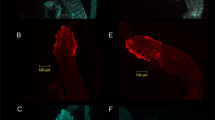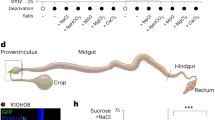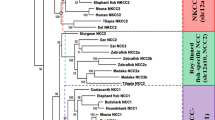Abstract
THE mechanism by which the salt gland of marine birds secretes a hypertonic solution of sodium chloride is of considerable interest. It is generally considered that the concentration gradient for sodium is established across the luminal membrane of the secretory cell by an electrogenic sodium pump1, but Hokin2, on the basis of measurements of the intracellular composition of salt gland slices in vitro, argued that the concentration gradient is established across the basal membrane. One of us (M. P.)3 repeated these experiments, however, and was unable to confirm Hokin's figures for the sodium and chloride content of salt gland cells. M. P. again proposed that sodium is actively transported from the intracellular fluid of low sodium concentration to the lumen of the tubules. Nevertheless, this does not preclude the possibility suggested by Hokin2 that sodium and chloride pass into the cell across the basal membrane by an active mechanism involving exchanges for H+ and HCO3−; indeed, current evidence favours this view1.
This is a preview of subscription content, access via your institution
Access options
Subscribe to this journal
Receive 51 print issues and online access
$199.00 per year
only $3.90 per issue
Buy this article
- Purchase on Springer Link
- Instant access to full article PDF
Prices may be subject to local taxes which are calculated during checkout
Similar content being viewed by others
References
Peaker, M., Phil. Trans. Roy. Soc., B, 262, 289 (1971).
Hokin, M. R., J. Gen. Physiol., 50, 2197 (1967).
Peaker, M., J. Physiol., 213, 399 (1971).
Whittam, R., and Ager, M. E., Biochem. J., 93, 337 (1964).
Maizels, M., J. Physiol., 195, 657 (1968).
Willis, J. S., and Fang, L. S. T., Biochim. Biophys. Acta, 219, 486 (1970).
Zerahn, K., Acta Physiol. Scand., 33, 347 (1955).
Herrera, F. C., Egea, R., and Herrera, A. M., Amer. J. Physiol., 220, 1501 (1971).
Keynes, R. D., and Swan, R. C., J. Physiol., 147, 626 (1959).
Hanwell, A., Linzell, J. L., and Peaker, M., J. Physiol., 210, 97P (1970).
Hanwell, A., Linzell, J. L., and Peaker, M., J. Physiol., 213, 373 (1971).
Hanwell, A., Linzell, J. L., and Peaker, M., J. Physiol., 213, 389 (1971).
Thesleff, S., and Schmidt-Nielsen, K., Amer. J. Physiol., 202. 597 (1962).
Author information
Authors and Affiliations
Rights and permissions
About this article
Cite this article
PEAKER, M., STOCKLEY, S. Lithium Secretion by the Salt Gland of the Goose. Nature 243, 297–298 (1973). https://doi.org/10.1038/243297a0
Received:
Revised:
Issue Date:
DOI: https://doi.org/10.1038/243297a0
This article is cited by
-
Isosmotic secretion in the avian nasal salt gland: X-ray microanalysis of luminal and intracellular ion distributions
Journal of Comparative Physiology B (1985)
-
The effects of lithium and methacholine on the intracellular ionic composition of goose salt gland slices: Relation to sodium and chloride transport
Experientia (1974)
Comments
By submitting a comment you agree to abide by our Terms and Community Guidelines. If you find something abusive or that does not comply with our terms or guidelines please flag it as inappropriate.



